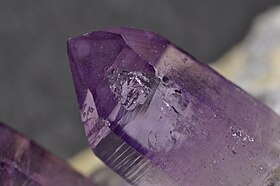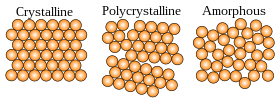
Back Kristal Afrikaans Cristal AN بلورة Arabic بلار ARY Cristal AST Kristallar Azerbaijani Kristall BAR Крышталічныя целы Byelorussian Крышталь BE-X-OLD Balur BEW


A crystal or crystalline solid is a solid material whose constituents (such as atoms, molecules, or ions) are arranged in a highly ordered microscopic structure, forming a crystal lattice that extends in all directions.[1][2] In addition, macroscopic single crystals are usually identifiable by their geometrical shape, consisting of flat faces with specific, characteristic orientations. The scientific study of crystals and crystal formation is known as crystallography. The process of crystal formation via mechanisms of crystal growth is called crystallization or solidification.
The word crystal derives from the Ancient Greek word κρύσταλλος (krustallos), meaning both "ice" and "rock crystal",[3] from κρύος (kruos), "icy cold, frost".[4][5]
Examples of large crystals include snowflakes, diamonds, and table salt. Most inorganic solids are not crystals but polycrystals, i.e. many microscopic crystals fused together into a single solid. Polycrystals include most metals, rocks, ceramics, and ice. A third category of solids is amorphous solids, where the atoms have no periodic structure whatsoever. Examples of amorphous solids include glass, wax, and many plastics.
Despite the name, lead crystal, crystal glass, and related products are not crystals, but rather types of glass, i.e. amorphous solids.
Crystals, or crystalline solids, are often used in pseudoscientific practices such as crystal therapy, and, along with gemstones, are sometimes associated with spellwork in Wiccan beliefs and related religious movements.[6][7][8]
- ^ Stephen Lower. "Chem1 online textbook—States of matter". Retrieved 2016-09-19.
- ^ Ashcroft and Mermin (1976). Solid State Physics.
- ^ κρύσταλλος, Henry George Liddell, Robert Scott, A Greek-English Lexicon, on Perseus Digital Library
- ^ κρύος, Henry George Liddell, Robert Scott, A Greek-English Lexicon, on Perseus Digital Library
- ^ "crys·tal". The American Heritage Dictionary of the English Language. Retrieved 2023-06-17.
- ^ Regal, Brian. (2009). Pseudoscience: A Critical Encyclopedia. Greenwood. p. 51. ISBN 978-0-313-35507-3
- ^ Patti Wigington (31 August 2016). "Using Crystals and Gemstones in Magic". About.com. Archived from the original on 15 November 2016. Retrieved 14 November 2016.
- ^ "The Magic of Crystals and Gemstones". WitchesLore. 14 December 2011. Retrieved 14 November 2016.